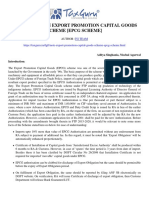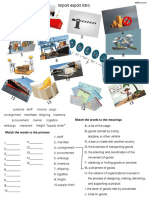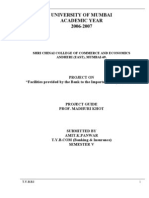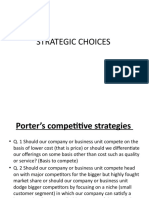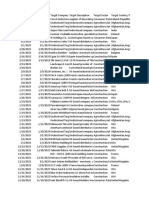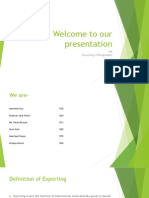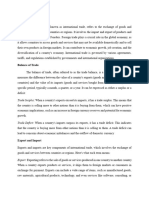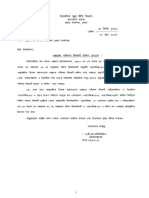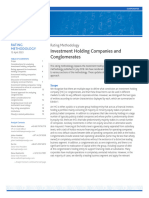Ecodev Import and Export
Uploaded by
Orlando Sanchez RimaEcodev Import and Export
Uploaded by
Orlando Sanchez Rima----------------------------------------------------------------------------
Slide
Import is the process of bringing in goods or services from another country for trade,
use, or processing. Exports, on the other hand, are the goods and services that a
country produces domestically, or within the borders of its own country, and sells to
buyers in a foreign country.
------------------------------------------------------------------------------------------
Notes:
Imports are goods or services that entities purchase from other countries, often via
shipment, mail or freight aircraft. Imports often represent goods that a country does
not produce or cannot produce affordably or efficiently. An importer can be an
individual or company. These entities may import goods to support their business or
sell to consumers in their home country. Imports result in an outflow of funds from
the country that is purchasing foreign goods and services.
Exports are one of the oldest forms of economic transfer and occur on a large scale
between nations and lead to an inflow of funds to the exporting country since export
transactions involve selling domestic goods and services to foreign buyers. Exporting
can bring profits to a country or money into a country, helping stimulate its economic
growth.
A country's importing and exporting activity can influence its GDP, exchange rate,
and level of inflation and interest rates. Moreover, a country's balance of trade ( the
difference between the value of a country's exports and the value of a country's
imports for a given period) can demonstrate the overall health of its economy, hence
it is important to know how to calculate a country’s met import and/or export.
----------------------------------------------------
SLIDE
Formula to determine a country's balance of trade:
Balance of trade (net exports) = total value of exports - total value of imports
Note:
Net imports are when a country imports more than it exports. To calculate net
imports, subtract net exports from net imports. This gives the same value as the net
export formula but the opposite sign, so a positive net import value means a company
imports more than it exports, and a negative net import value means the company
exports more than it imports.
---------------------------------------------------------------------------------------
A positive net export figure shows a country’s trade surplus. It means that the
value of the nation’s imports is lower than the value of its exports. A trade surplus can
represent a healthy economy, as it demonstrates a positive flow of currency from
foreign entities wherein a country receives more money from a foreign market than it
spends.
A negative net export figure is a trade deficit for a given country. It means that
the overall value of the country’s imports is greater than the overall value of its
exports. A country with a trade deficit spends more money in a foreign market than it
makes. As a result, the country may need to borrow money to pay for additional
imports and cover its deficit.
-------------------------------------------------------------------
SLIDE
How does imports and exports affect the GDP of a country?
The gross domestic product (GDP) of a country represents the total monetary value of
all the goods and services it produces within a specified period. When a country
exports products, it sells them to governments, businesses or consumers in another
country. Those exports provide income to the exporting country, thus increasing its
GDP. When a country imports products, it purchases them from foreign
manufacturers and entities. The money spent elsewhere leaves the importing country's
economy, thus potentially decreasing its GDP.
Highlights of the Philippine Export and Import Statistics December 2022 (Preliminary)
| Philippine Statistics Authority (psa.gov.ph)
SLIDE
In December 2022, the country’s total external trade in goods amounted to USD 15.93
billion, which indicates an annual decline of -9.9 percent from its level in the same
period of the previous year. In November 2022, its annual increase was faster at 3.8
percent, while in December 2021, it expanded at an even faster rate of 24.8 percent.
Of the total external trade in December 2022, 64.4 percent were imported goods,
while the rest were exported goods.
SLIDE
The balance of trade in goods (BoT-G) is the difference between the value of export
and import. The BoT-G in December 2022 amounted to USD -4.60 billion, indicating
a trade deficit with an annual decrease of -10.2 percent. The trade deficit in the
previous month recorded an annual decline of -21.3 percent, while in December 2021,
it posted an annual increase of 108.9 percent.
SLIDE
By major trading partners, exports to People’s Republic of China comprised the
highest export value amounting to USD 980.84 million or a share of 17.3 percent to
the total exports during the month.
Completing the top five major export trading partners with their export values and
percent shares to the total exports were:
a. United States of America (USA), USD 811.50 million (14.3%);
b. Japan, USD 793.58 million (14.0%);
c. Hong Kong, USD 569.93 million (10.1%); and
d. Singapore, USD 346.41 million (6.1%).
SLIDE
The People’s Republic of China was the country’s biggest supplier of imported
goods valued at USD 2.33 billion or 22.7 percent of the total imports in December
2022. Completing the top five major import trading partners with their corresponding
import values and percent shares to the total imports were:
a. Indonesia, USD 1.07 billion (10.4%);
b. Japan, USD 809.85 million (7.9%);
c. USA, USD 699.75 million (6.8%); and
d. Republic of Korea, USD 697.85 million (6.8%).
You might also like
- Member-Managed LLC Operating Agreement Template TemplateNo ratings yetMember-Managed LLC Operating Agreement Template Template5 pages
- A Brief Note On Export Promotion Capital Goods Scheme (EPCG Scheme) - Taxguru - inNo ratings yetA Brief Note On Export Promotion Capital Goods Scheme (EPCG Scheme) - Taxguru - in6 pages
- Philippine Export Guidebook 2015 EditionNo ratings yetPhilippine Export Guidebook 2015 Edition105 pages
- Bull Machine Import Export Inc Sale ContractNo ratings yetBull Machine Import Export Inc Sale Contract3 pages
- Myanmar Procedures For Export and Import and Customs Clearance100% (2)Myanmar Procedures For Export and Import and Customs Clearance5 pages
- Sales in Course of Import and High Seas Sales Under CST ActNo ratings yetSales in Course of Import and High Seas Sales Under CST Act23 pages
- Economic Success Story South Korean WayNo ratings yetEconomic Success Story South Korean Way12 pages
- Chapter-6 - Importing, Exporting and Trade Relations-1No ratings yetChapter-6 - Importing, Exporting and Trade Relations-112 pages
- External Sector Performance - July 2022No ratings yetExternal Sector Performance - July 202213 pages
- A Comparative Evaluation Between National and International Trade and Explain The Concept of Geographical Indication and It100% (1)A Comparative Evaluation Between National and International Trade and Explain The Concept of Geographical Indication and It15 pages
- ADL 85 Export, Import Procedures & Documentation V2No ratings yetADL 85 Export, Import Procedures & Documentation V223 pages
- Facilities Provided by The Bank To Importer & Exporter67% (9)Facilities Provided by The Bank To Importer & Exporter65 pages
- Import Export Documentation and ProceduresNo ratings yetImport Export Documentation and Procedures107 pages
- Mergermarket Deals Export 20230403 14468c9eNo ratings yetMergermarket Deals Export 20230403 14468c9e92 pages
- Implications of Foreign Trade Policy and Facilitation of Foreign TradeNo ratings yetImplications of Foreign Trade Policy and Facilitation of Foreign Trade32 pages
- Afghanistan Customs Tariff 2014 EnglishNo ratings yetAfghanistan Customs Tariff 2014 English445 pages
- Y12 Chapter 30_ GOVERNMENT EXPENDITURE AND NET TRADENo ratings yetY12 Chapter 30_ GOVERNMENT EXPENDITURE AND NET TRADE3 pages
- 1 Submission of Exchange Position StatementNo ratings yet1 Submission of Exchange Position Statement10 pages
- Canadian Dollar To Naira - Google Search PDFNo ratings yetCanadian Dollar To Naira - Google Search PDF1 page
- TXN Date Value Date Description Ref No./Cheque No. Debit Credit BalanceNo ratings yetTXN Date Value Date Description Ref No./Cheque No. Debit Credit Balance9 pages
- Lecture Notes Significance of Location of PakistanNo ratings yetLecture Notes Significance of Location of Pakistan11 pages
- nhse-kss---early-years-24-month-programme-joint-df-and-dct-schemeNo ratings yetnhse-kss---early-years-24-month-programme-joint-df-and-dct-scheme4 pages
- Week 1 Lesson 1 Knowledge and Concept of EntrepreneurshipNo ratings yetWeek 1 Lesson 1 Knowledge and Concept of Entrepreneurship8 pages
- Public Policy Orientation: Sherwin William A. Cuasay, PHD, Enp, LPT University of Batangas Graduate SchoolNo ratings yetPublic Policy Orientation: Sherwin William A. Cuasay, PHD, Enp, LPT University of Batangas Graduate School17 pages
- Rating Methodology - Investment Holding Companies and ConglomeratesNo ratings yetRating Methodology - Investment Holding Companies and Conglomerates23 pages
- Handbook of Production Economics Subhash C. Ray (Editor) pdf download100% (3)Handbook of Production Economics Subhash C. Ray (Editor) pdf download79 pages
- Indian Financial System MCQS: Answer:-D. Corporation BondsNo ratings yetIndian Financial System MCQS: Answer:-D. Corporation Bonds8 pages







